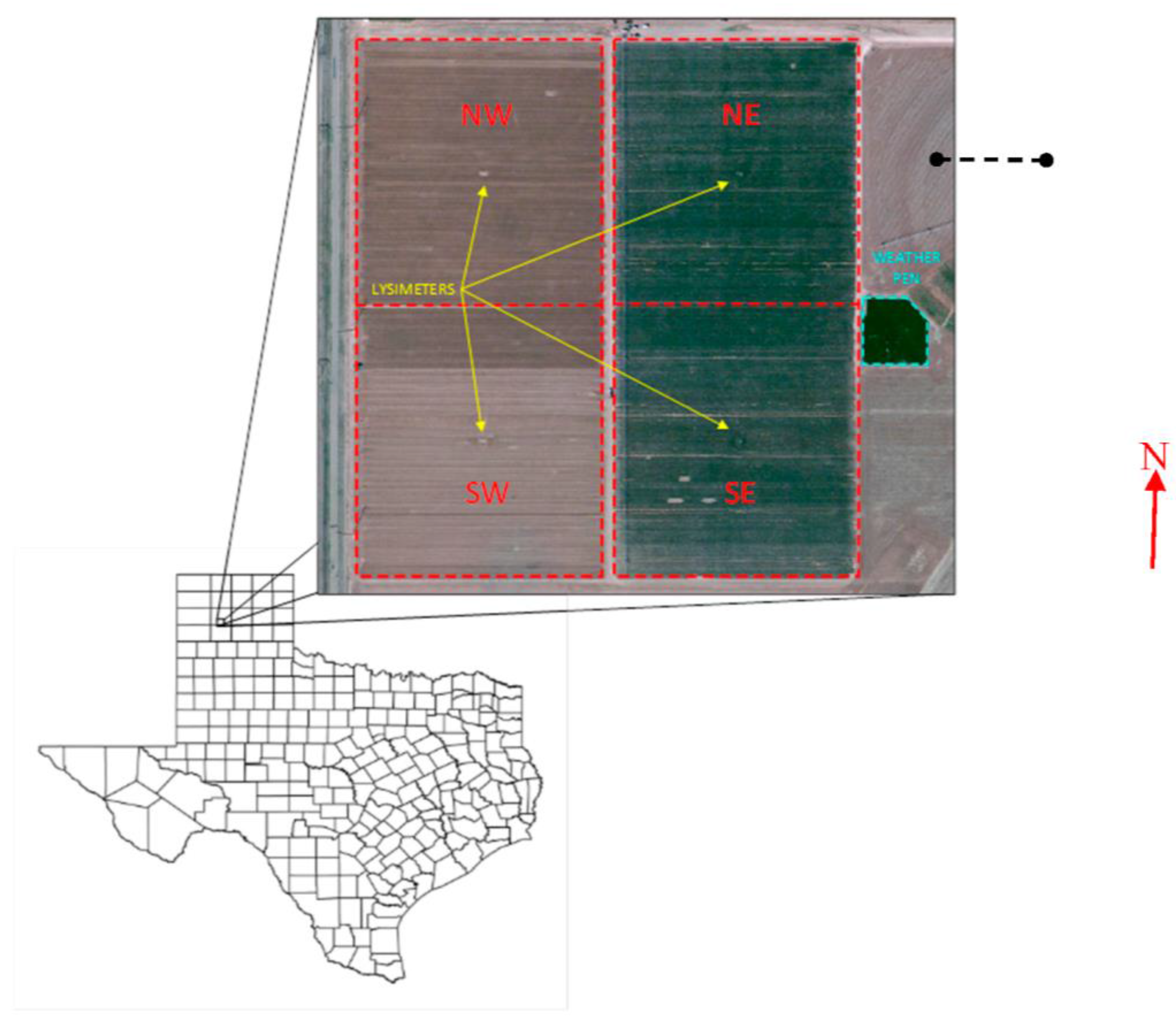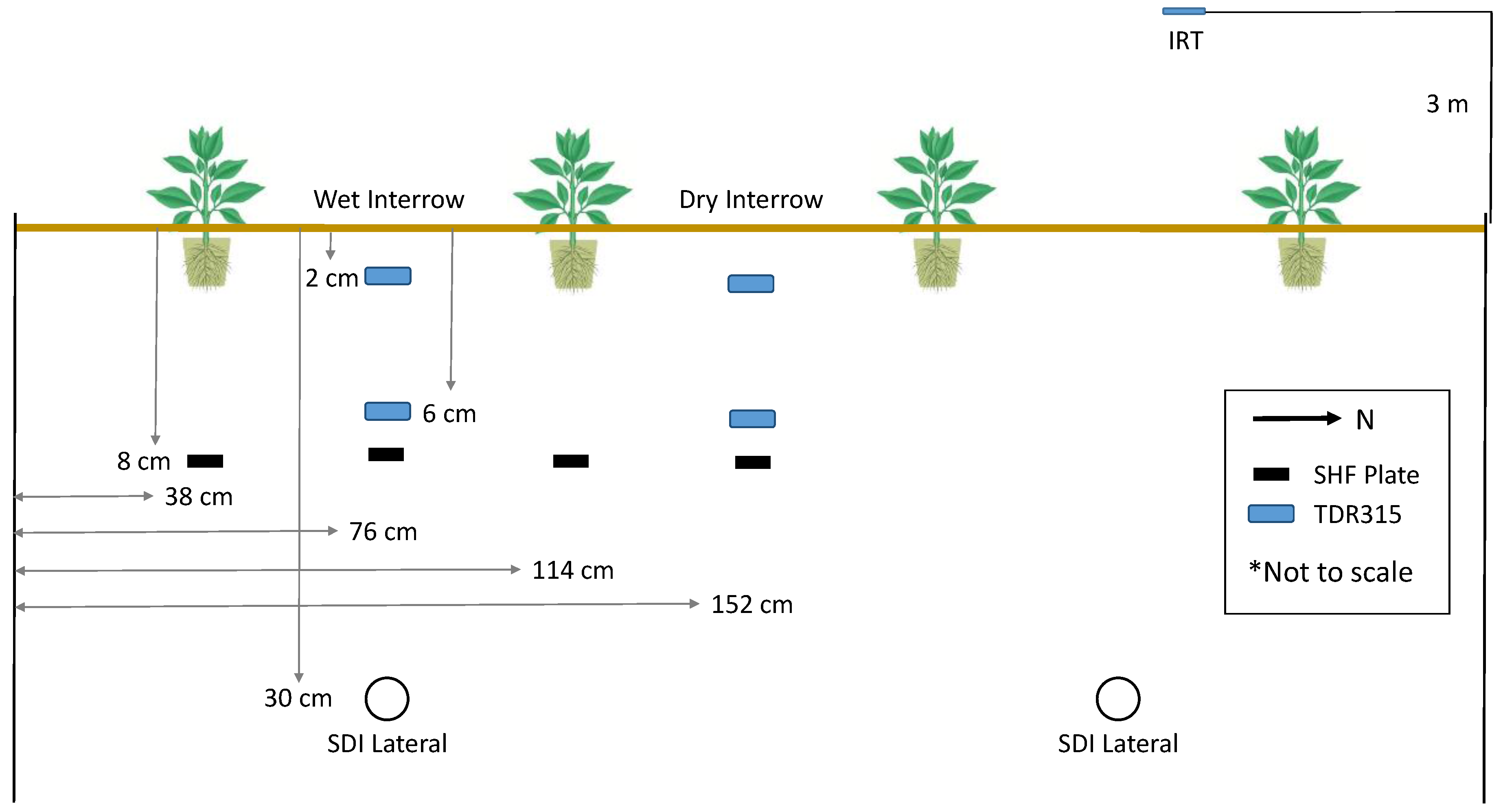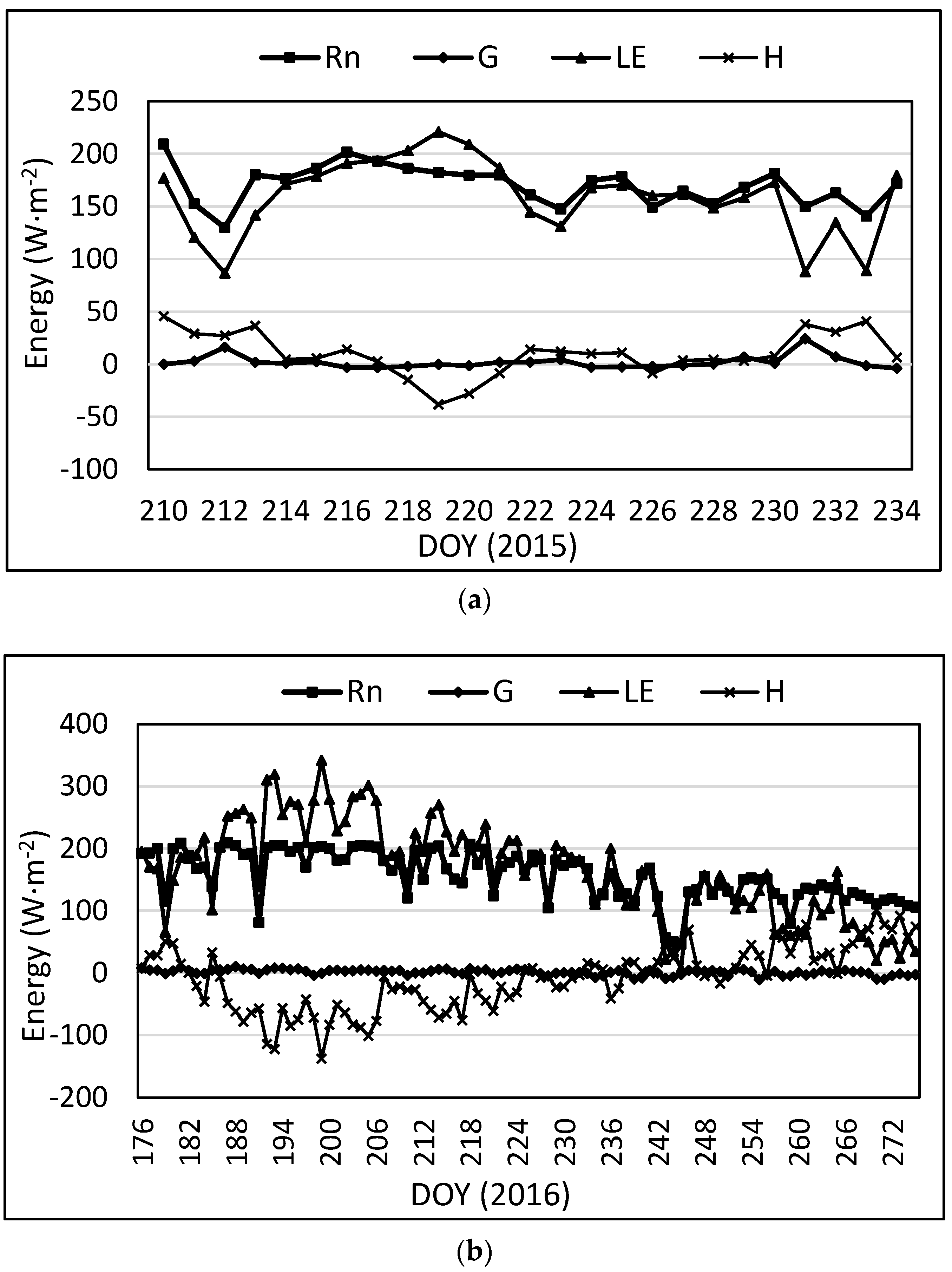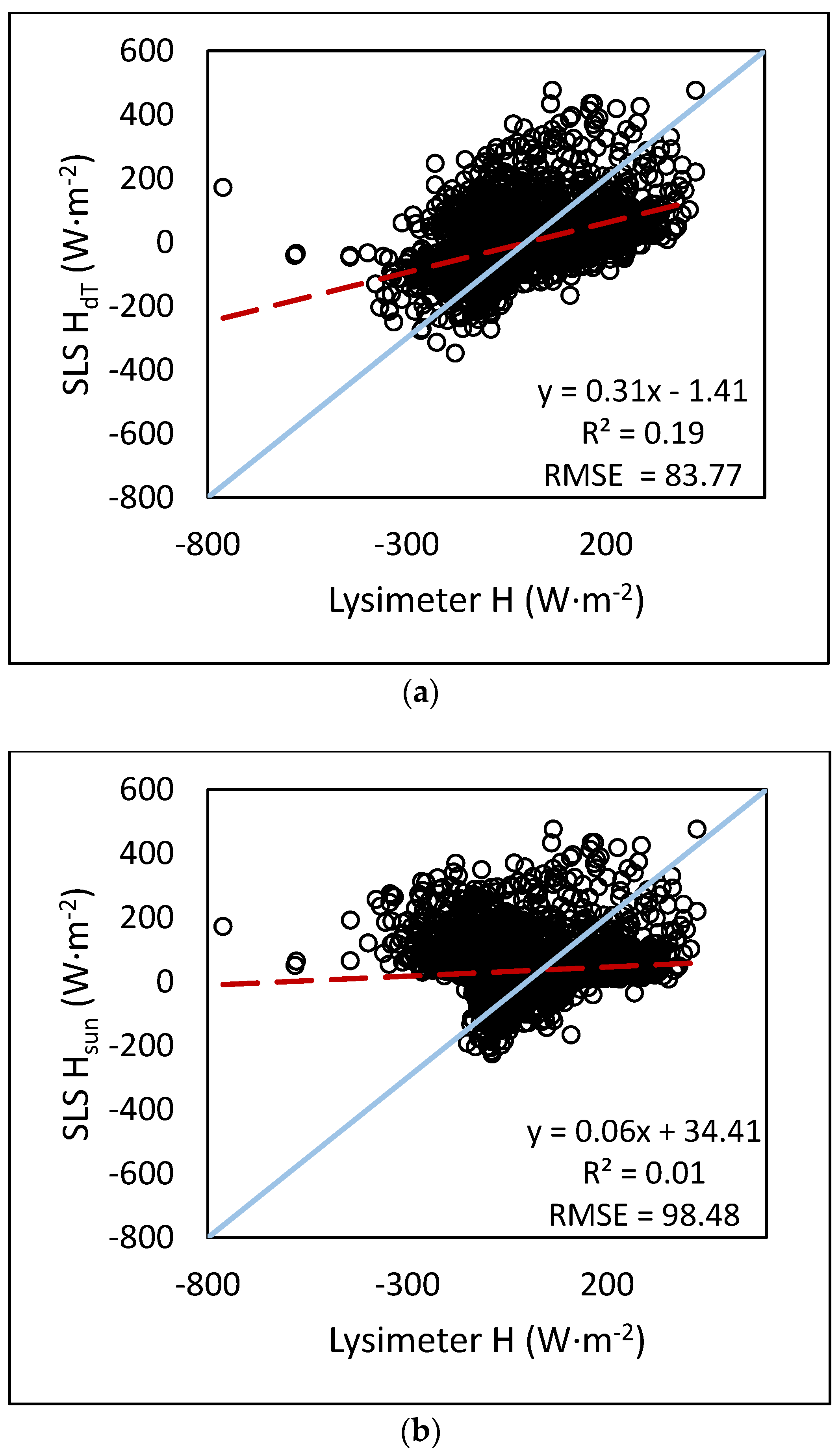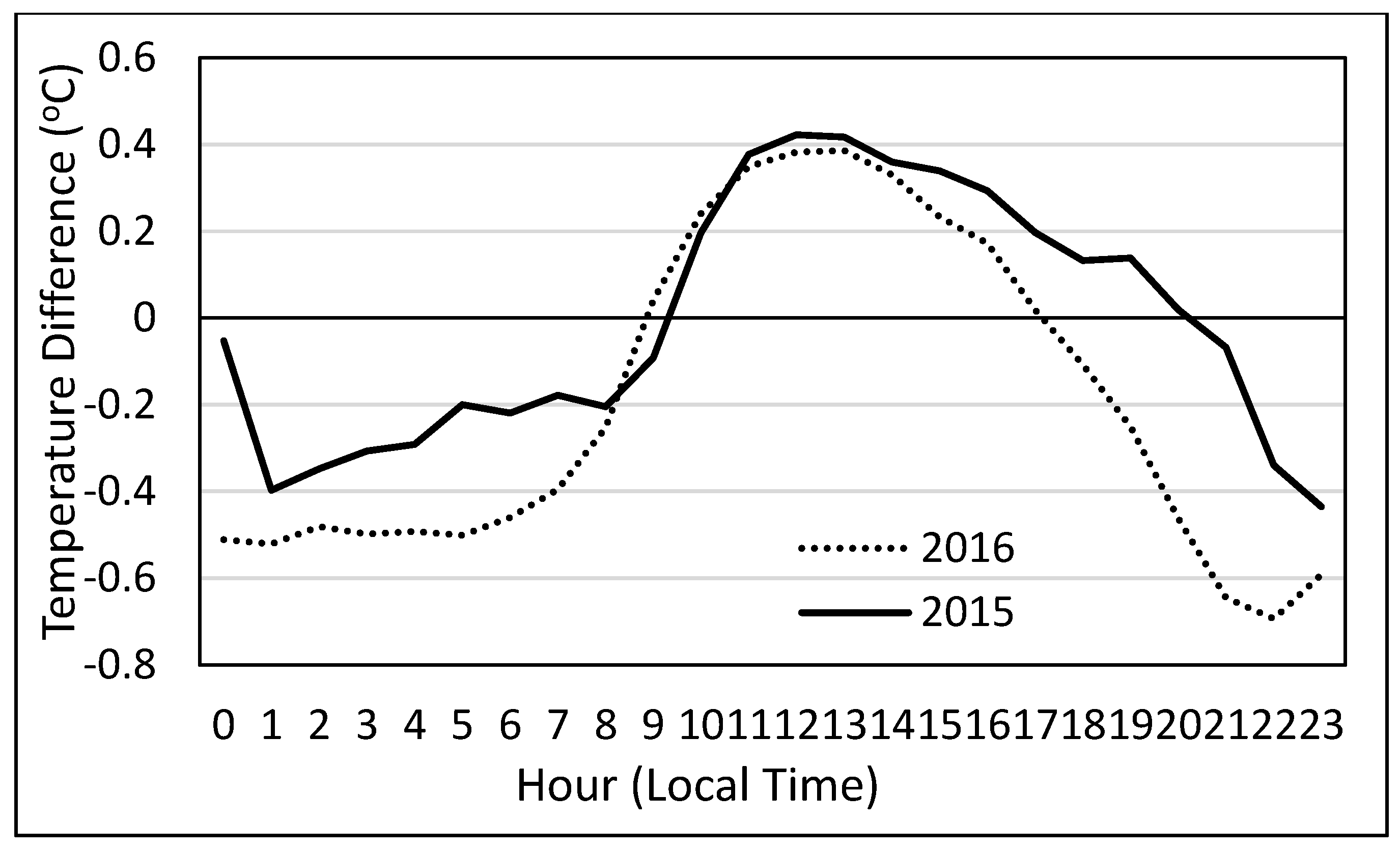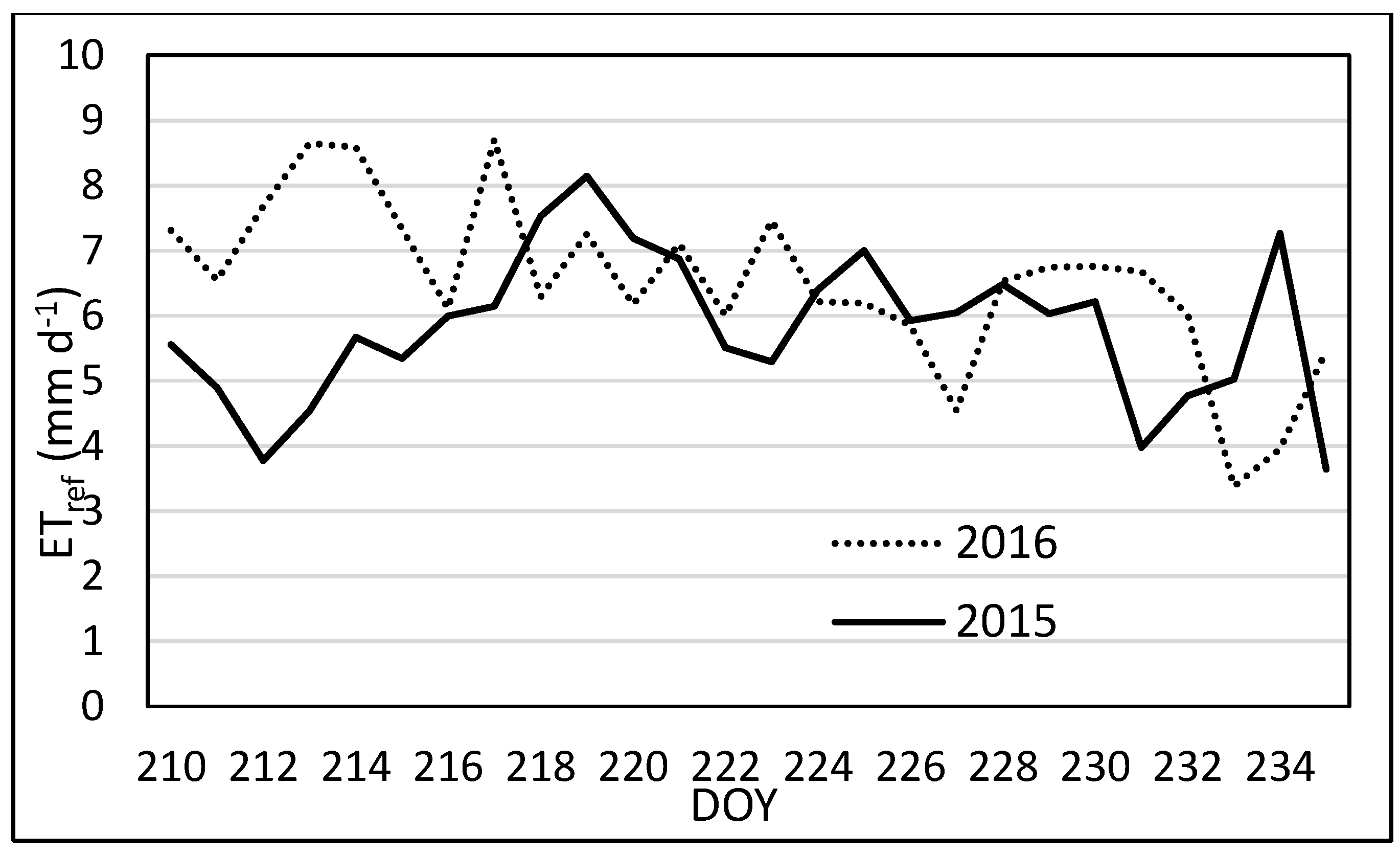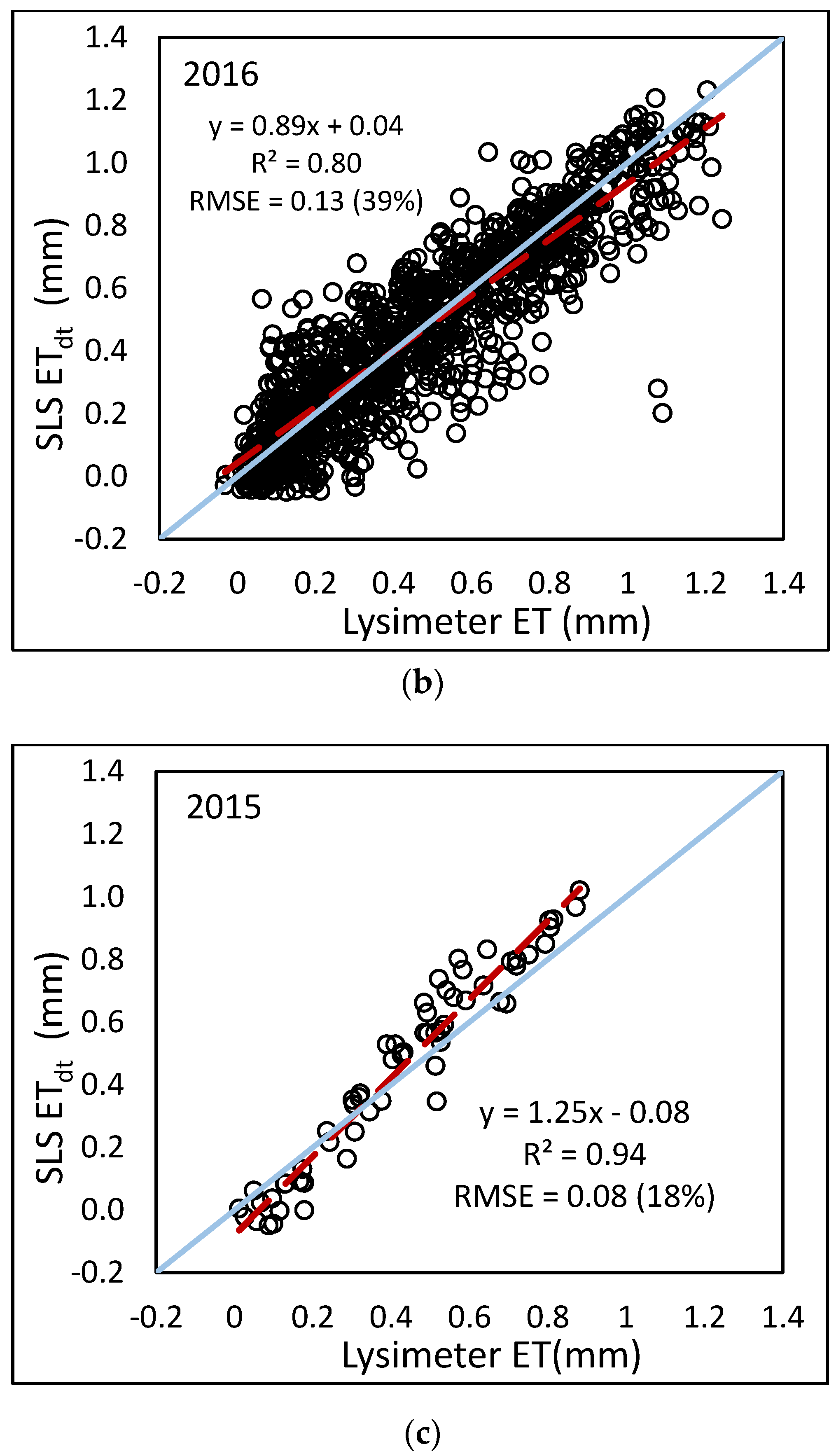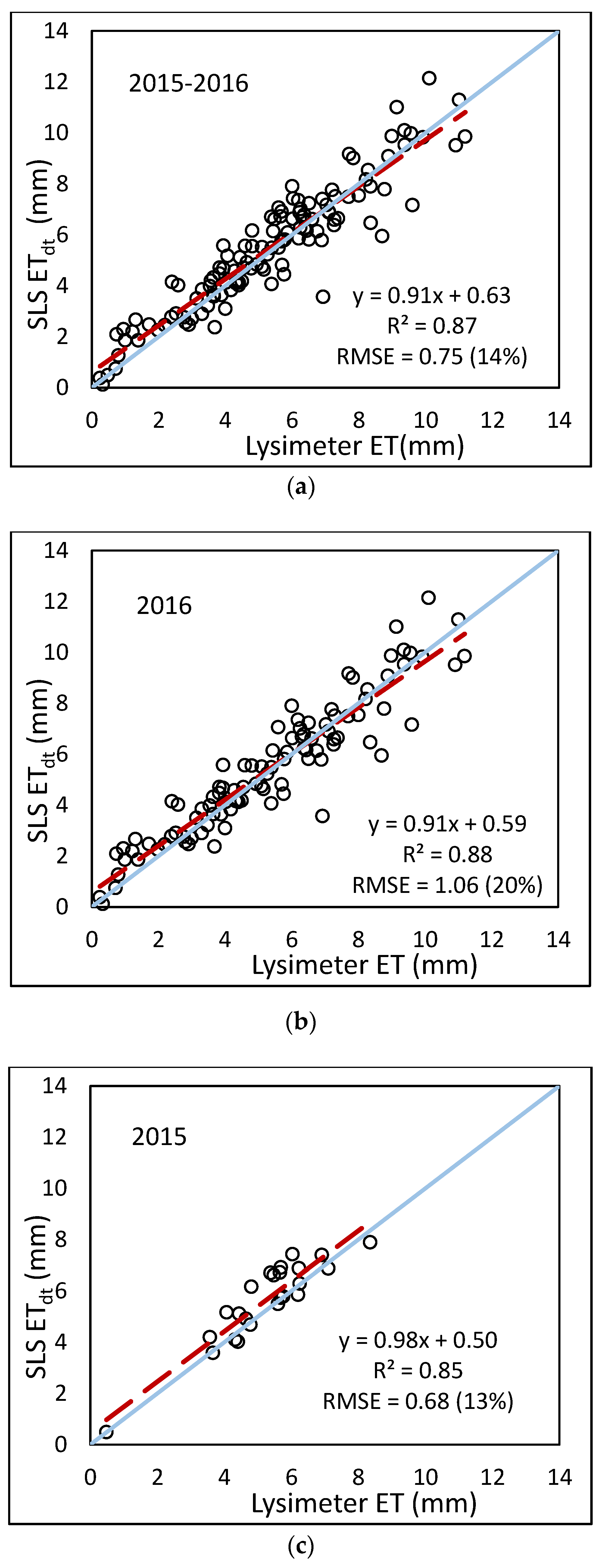1. Introduction
In arid and semi-arid regions of the world such as the Texas High Plains, finite groundwater resources are being mined, often with little to no surface water available as an alternate irrigation source. In the Texas High Plains, irrigation pumping for agricultural crop production accounts for the overwhelming majority of total groundwater withdrawals [
1]. Effective irrigation management is essential for extending the longevity of limited water resources in these intensively irrigated production areas. Most effective irrigation management (scheduling) strategies rely on accurate estimates of evapotranspiration (ET) to account for crop water use and evaporative water losses. ET is a term that represents water lost through evaporation from the soil or plant surface and water used through plant transpiration. In the Texas High Plains, ET is the largest water loss component in the soil water budget [
1,
2]; hence, accurate ET estimates are vital for determining crop water demand and managing irrigation. Groundwater recharge in the Texas High Plains, and the surrounding Southern Ogallala Aquifer region can be as low as ~11 mm year
−1 [
3]. With such small recharge rates, the Ogallala Aquifer is essentially a finite water resource. Assuming an 11 mm recharge rate across all 5.4 million ha (13.4 million ac) in the northern half of the Texas panhandle (Texas Water Development Board Region A) would supply 0.60 km
3 (484,000 ac-ft) of recharge to the aquifer. In contrast, 2010 agricultural water withdrawals were estimated to be 1.81 km
3 (1.47 million ac-ft) for the same area [
1]. Water conservation, in part through ET-based irrigation scheduling, is paramount to extending the longevity of this limited water resource for future generations.
Accurate measurement or estimation of ET can be difficult; however, numerous instruments and methods are available. One widely used method is the reference ET (ET
ref) and crop coefficient product. Meteorological data are used to estimate ET
ref, which corresponds to the water demand of a reference crop, either a short, clipped grass or alfalfa [
4]. To obtain ET for a specific crop using reference ET, a crop coefficient (K
c) is used to adjust reference ET to crop specific ET, or ET
c; thus, ET
c = K
c × ET
ref [
5]. For irrigation scheduling, ET
c is typically calculated at a daily time step. ET
c estimates the amount of water that would be used by that crop if there were no water limitation for crop growth. Actual (field-based) crop ET may be less than ET
c due to stresses from insufficient available water, nutrients, pests, etc. As such, actual ET would potentially be more useful than ET
ref or ET
c for irrigation management. An issue with using actual ET in irrigation scheduling is that ET can be very difficult to determine accurately. Where ET
ref can be calculated from weather parameters using a weather station with a reference surface, efforts to determine actual ET not only require more advanced (and expensive) instrumentation but still only result in an estimate of ET. Current technologies for determining ET estimates include lysimeters, Bowen Ratio, Eddy Covariance (EC), scintillometry, field water balance using soil water measurements, remote sensing models, and others.
The aforementioned methods can all be used to estimate ET; however there are disadvantages of each. With the soil water balance approach, drainage and runoff components can be difficult to accurately determine. Although they are commonly considered relatively small in arid and semiarid regions, they need to be accounted for to obtain the best accuracy. In addition, soil water measurements are valid for a small point in a field creating spatial representation concerns. Weighing lysimeters are the most accurate method of assessing ET [
6], but they are very expensive to install, maintain, and operate. In addition, they require a high level of operational knowledge and data processing experience to obtain accurate and representative measurements. Large weighing lysimeters are typically considered research tools and are not practical for generalized irrigation scheduling. The Bowen Ratio method has been used to determine ET from the energy balance, but it is an indirect measurement and can have issues of instrument bias and data discontinuity when the Bowen Ratio approaches −1 [
7]. EC is a method of estimating turbulent fluxes and ET, but is known to have significant energy balance closure errors [
8,
9,
10]. Remote sensing models have been extensively used for ET mapping; however, they have been commonly evaluated using EC [
11,
12,
13]. Some studies have evaluated remote sensing ET using lysimeters [
14,
15,
16], though lysimeter data are not available in many regions. Other, simpler methods to achieve highly accurate ET data would greatly benefit future research. Scintillometers are another type of indirect measurement instrument that has been extensively used for surface atmospheric dynamics research, but they can also have large errors. EC and scintillometry are two of the more common turbulent flux and ET methods typically used. They are relatively inexpensive and easy to deploy and maintain; and provide spatially averaged data. Scintillometers measure contributions to fluxes over a fixed path length and EC can measure contributions to fluxes over a variable area influenced by wind movement. The spatial average nature of EC and scintillometers account for variation within the area of measurement and provide a degree of representativeness. The main issue with the EC method is the lack of accuracy, as reported throughout the literature. Although scintillometers are being used in atmospheric research [
17], applications in irrigation management research are relatively new and few in number. A thorough evaluation of scintillometers is needed to determine if they are suitable to measure ET for the purposes of irrigation scheduling and developing crop coefficients. Scintillometers are commonly used with the energy balance equation to determine ET from scintillometer measurements.
1.1. Energy Balance
In many studies, scintillometers are used with the energy balance. The energy balance equation is:
where
Rn is the net radiation,
LE is the latent heat flux,
H is the sensible heat flux, and
G is the soil heat flux (all with units of W·m
−2) [
18,
19]. The energy balance explains the dynamics for the dispersion of radiant energy from the sun to the land surface. Energy from the sun is either reflected or absorbed. The portion absorbed is the
Rn, where it is positive when energy moves toward the surface (plant canopy) and negative when it moves from the surface. The absorbed
Rn can then be distributed to the soil as
G, to the air as
H, or provide energy to evaporate water as
LE. Sign conventions for Equation (1) vary, but in this study,
G is positive when flux moves toward the soil surface,
LE is positive when flux moves toward the plant canopy, and
H is positive as flux moves from the canopy to the air.
1.2. Scintillometry
A scintillometer consists of a transmitter and receiver, separated by a specified path length. Scintillometry, as applied to agricultural and other landscapes, uses a beam of electromagnetic radiation of known wavelength transmitted across a relatively large distance (100 m–4.5 km). The beam intensity fluctuates due to absorption and diffraction as it encounters eddies in the air. These fluctuations, or scintillations, can be used to determine the structural parameter of the refractive index of air, which can be used to calculate the structural parameters for temperature and humidity, and
H. The calculations to obtain
H from scintillometers are based on the Monin–Obukhov Similarity Theory (MOST). Details of MOST can be found in Arya [
20], Foken [
21], Hartogensis [
22], McAneney et al. [
23] and Monin et al. [
24].
The main output of a scintillometer is the natural logarithm of the received beam intensity. Since the SLS uses two parallel beams, the calculation methodology is different. By using two beams, the covariance between the two can be calculated as:
where
B12 is the covariance between the beams,
K is the wavenumber (
K = 2
π/
λ rad m
−1),
D is the detector diameter (mm),
d is the beam separation distance (mm),
L is the path length (m),
x is the coordinate along the path,
k is the von Karman constant,
ϕn is the three dimensional spectrum of the refractive index inhomogeneities, and
J0 and
J1 are Bessel functions of the first kind [
25]. The term
ϕn is calculated as:
where
is the structural parameter of the refractive index of air (m
−2/3) and
fϕ(
k) is the refractive index decay function. Equation (3) can be inserted into Equation (2) to define the covariance and the variance if
, the inner scale of turbulence (
), and the instrument physical dimensions are known, thus allowing the use of
B12 and
B1 or
B2 to derive
and
[
25]. Since the SLS measures variances in intensity,
, rather than variances of log amplitude,
Bi,
must be converted to
Bi:
where
Ii is the intensity [
25]. From the SLS,
can be calculated from
as:
where
T is the temperature in Kelvin,
p is the atmospheric pressure in mbar, and
a is a constant of 7.89 × 10
−5 K/mbar at the 670 nm wavelength [
25].
One advantage SLS offers over other point source measurements, is that the fluxes can be determined over shorter lengths and at heights closer to the surface [
26]. Also, the SLS determines the
, which is proportional to the dissipation rate of the turbulent kinetic energy,
ε, which are used to determine the friction velocity (
) and temperature scale (
). Sensible heat flux is calculated from
and
as:
where
is the specific heat of air (kJ·kg
−1) and
is the air density (kg·m
−3). The complete process to determine
H from the SLS is provided in Savage [
27] and Scintec [
25].
Many different models of scintillometers are available, which differ based on their wavelength and aperture diameter. The large-aperture scintillometer (LAS) has a wavelength around 880 nm and an aperture of 10–30 cm. Microwave scintillometers (MWS) have an aperture around 30 cm and a wavelength of 1–3 mm. Several studies have evaluated scintillometry using the LAS and/or the MWS due to their long operational range. The MWS is noted to have the ability to measure LE directly [
28,
29,
30] as the wavelength is sensitive to humidity fluctuations. Samain et al. [
31] found RMSE values of approximately 14 W·m
−2 for both LE and H between ETLook, TOPMODEL-based Land-Atmosphere Transfer Scheme (TOPLATS), and a LAS. Samain and Pauwels [
32] found an RMSE of 0.1 mm·d
−1 between an LAS and ET calculated from the Penman–Monteith equation. Meijninger et al. [
33] found LE from a single LAS and a dual LAS–MWS setup were within 25% of the LE obtained from EC. Guyot et al. [
34] found good agreement from a LAS as compared to EC and the water balance approach. Yee et al. [
35] found a standalone LAS to be more suitable than the two-wavelength approach or a standalone MWS for a semi-arid environment. Studies evaluating a LAS or validating using instruments other than a lysimeter are abundant in the literature [
28,
36,
37,
38,
39,
40,
41,
42,
43].
The SLS has been available for many years; however, SLS agricultural and crop-based studies are not abundant in the literature. Research related to the LAS or MWS vastly outweighs research using the SLS. Most SLS literature is related to atmospheric research and the number of publications is still small compared to other instruments. A few studies illustrate the benefits of the SLS over other flux measurement instruments, such as EC. Odhiambo and Savage [
44] provided benefits and disadvantages of SLS, as well as an overview of scintillometry and various scintillometers. They note that the operation of a scintillometer using a path average approach provides the benefit of allowing for shorter time intervals. In addition, scintillometry does not require corrections (such as frequency response corrections for EC), that are generally subjective, to be applied. Lastly, Odhiambo and Savage [
44] mentioned that since the variance of the logarithm of beam amplitude is the measurement used, any calibration multipliers and constants cancel or are removed by band-pass filtering. The disadvantages given by Odhiambo and Savage [
44] include using MOST, which requires the effective beam height and zero-plane displacement height. In addition, the scintillometer itself cannot determine the direction of H, so the temperature difference from additional temperature sensors or other methods must be used to determine the flux direction.
Savage et al. [
45] investigated H using a SLS, in addition to EC and Bowen Ratio, over natural grassland over a longer time period. They noted that most SLS studies were rather short, commonly with a time frame of a few days to a few weeks. Therefore, they performed an analysis using more than 30 months of data. They used averaging periods of two minutes for energy balance components, ET
ref estimates, and SLS measurements, 20 min for Bowen Ratio, and 30 min for EC. Their regression analysis of daily ET between Bowen Ratio to SLS (BR-SLS) showed an r
2 of 0.87, while a similar analysis of EC to SLS (EC-SLS) showed improved correlation with an r
2 of 0.96. The ET estimate comparison showed an RMSE of 0.58 mm·d
−1 for the SLS-BR and 0.31 mm·d
−1 for SLS-EC. Comparisons to ET
ref were not made.
De Bruin et al. [
46] also found good correlation between H from an EC system and SLS near Uppsala, Sweden over a mixed landscape encompassing mostly agricultural land. Their regression analysis showed the flux from the EC was 1% greater and the flux comparison between EC and SLS had an r
2 of 0.95. They also compared
from the SLS and EC and found an r
2 of 0.87.
Nakaya et al. [
47] compared an SLS with an EC system over a deciduous forest in Japan. They found the SLS to overestimate H and the LE, as compared to their EC system. Since EC systems often underestimate LE, the SLS values could have been closer to the real LE. They also observed that the SLS underestimated
, especially when the values of
were large. They concluded that the cause in the underestimation of
is due to systematic errors in the determination of
l0.
Hartogensis et al. [
48] analyzed data from a SLS using data from the Co-operative Atmosphere Surface Exchange Study (CASES-99) experiment conducted in Kansas. They noted the benefits associated with using an SLS over EC, including a shorter averaging interval, shorter measurement height, and shorter path length, while also noting some disadvantages to the SLS. They noted that conversion from
l0 and
to H is done empirically using MOST. This can result in a bias in
l0, causing an overestimation of
for small
values and underestimation of
for large
values [
46]. The CASES-99 experiment deployed both a SLS and an EC system. Hartogensis, De Bruin and Van de Wiel [
48] found that from the shorter averaging interval from the SLS (6 s for CASES-99), intermittent turbulence could be detected, whereas the longer averaging interval for the EC (30 min) would mask some of the intermittent turbulence. Comparing the
ε, they showed the bias in the
l0 caused a bias in the SLS
ε where an overestimation of
ε occurred for small values of
ε and an underestimation occurred for large values of
ε. Comparing
ε obtained from SLS and EC showed good agreement between the two instruments. Comparing
obtained from SLS and EC showed less agreement where the SLS
was consistently larger [
48]. In their analysis of H, they found the SLS to overestimate the EC H for fluxes greater than −50 W·m
−2. They concluded that most of the error in the SLS data, as compared to EC, can be improved upon by taking the aperture diameter as 2.6 mm instead of the manufacturer reported 2.7 mm. This was tested in response to a finding in De Bruin et al. [
46] where empirical functions were proposed to account for noise and inactive turbulence (where turbulence does not create mixing).
The previously described studies reiterate that evaluation of the SLS has used EC as validation. SLS studies involving lysimeter comparisons were not found in the literature and leave an opportunity for evaluation against highly accurate data. In addition, the SLS has not been widely evaluated for determining ET. In this study, an SLS was evaluated against data from a large weighing lysimeter for determination of hourly and daily H and ET for agricultural crops.
3. Results
Daily ET
lys values for 2015 and 2016, as well as crop height and leaf area index (LAI) are presented in
Figure 3. An exceptionally wet year occurred in 2015 for the study location, which may have caused greater evaporation and thus higher ET
lys values as compared to 2016 for the same date range. Since the lysimeter field is irrigated using subsurface drip, the soil surface is typically dry and evaporation is minimized. When a precipitation event occurs, the soil and plant surfaces become wet and experience evaporation that does not occur with irrigation as the irrigation water typically does not reach the soil surface. In addition, during the data period for 2015, the sorghum crop was still in a vegetative growth stage with higher relative ET. The data for 2016 encompasses vegetative growth of the corn crop, but also, late season reproductive growth and grain filling. During the corn grain fill stage, ET
lys is lower and possibly reduced the overall hourly average values. Both years exhibit the pattern of lower ET
lys during the night hours, increasing from sunrise to a maximum around 14:00 and then decreasing. Although ET
lys is drastically reduced during the night, the measured ET
lys values illustrate that a small amount of ET does occur at night, which is not negligible [
56].
Energy balance closure was 87% (based on the slope of the regression equation) when the available energy (AE:
Rn-
G) was regressed against H
dT + LE
lys. The energy balance closure error was similar to the %RMSE for H
dt (87% and 83%, respectively. This similarity leads to the inference that the energy balance closure error results from error in H
dt as compared to H
lys. The results of the error analyses for the turbulent fluxes and ET
sls are presented in
Table 1. Even though the H
sls had weak correlation with the H
lys, and a large error, the resulting ET
sls had a much smaller error, especially for daily ET
sls. This indicates that errors in determining H do not have a drastic impact on ET
sls. In irrigated agriculture, H is commonly small, especially compared to LE. Large errors in a small component may not result in large error in the final product. Results for the AE and incoming solar irradiance regressed against ET
lys are also included in
Table 1. This analysis showed the extent of error associated with estimating ET without measuring H. The slopes for the regression equations from AE and irradiance are provided in
Table 1; however, the slope values are much larger than for ET and H since AE and irradiance values are considerably larger than ET. Errors for ET were larger using AE and irradiance as predictors of ET, which indicates that although large errors exist for H
sls, ET
sls errors are still lower when accounting for the H component. The error rates and small error suggest that potential exists for additional research and potential improvements in SLS measurements for H, and possibly the resulting ET
sls.
The average daily energy balance components for the lysimeter are presented in
Figure 4. From the figure,
Rn and LE had the largest values, and H and
G had much lower values. Since
Rn is the main energy input, when one component (LE) increases, another component (H) should decrease. This is not always the case as the environment in the Texas High Plains commonly generates advection where heat energy is transferred from a warmer, typically drier adjacent field to cooler irrigated fields. Evidence of advection is also seen in cases where
LE exceeds
Rn [
7,
57]. The influx of heat energy from nearby (warmer) fields increases the energy available for evaporation of water during transpiration, thus increasing the latent heat flux.
Figure 5 presents average daily data for all four components of the energy balance equation as determined by the SLS. For the SLS, the temperature difference was used to determine flux direction for H shown in
Figure 5. In some instances,
LE is greater than
Rn during the daytime, which in this case, corresponds to instances where LE was greater than
Rn with the lysimeter. This usually indicates the occurrence of advection rather than an
LE error since the same higher LE was measured on the lysimeter for the same dates.
The results from the statistical analyses of H showed that using the temperature gradient produced a lower error than using H
sun. The assumption that the atmosphere was stable at night and unstable during the day proved to not always be true. Comparisons of H
dT and H
sun are presented in
Figure 6. The SLS overestimated H as compared to the lysimeter, which is illustrated by
Figure 6 as well as the slope of the regression equation (0.31 and 0.06, respectively). H
dt from the SLS ranged from −347.7 to 475.8 W·m
−2 with a mean of −5.1 W·m
−2 and a standard deviation of 92.8 W·m
−2. H
sun from the SLS ranged from −226.6 to 475.8 W·m
−2 with a mean of 33.6 W·m
−2 and a standard deviation of 93.7 W·m
−2. H determined from the lysimeter ranged from −761.7 to 426.4 W·m
−2 with a mean of −11.4 W·m
−2 and a standard deviation of 130.1 W·m
−2. The lysimeter showed a broader range of H values compared to the SLS, although mostly with regard to negative flux values. Although weak correlation is shown in
Figure 6, the statistical analysis showed significant correlation (
p < 0.05) for all data periods (2015 only, 2016 only, and 2015–2016) for H. The regression analyses showed all slopes were significant and all intercepts were significant (
p < 0.05) with the exception of H
dT for the combined 2015–2016 dataset (
p = 0.27). The measurement footprints of the lysimeter and SLS are not exactly the same. The lysimeter measures a 3 m by 3 m square whereas the SLS measures an average across the 100 m path, which is 25 m north of the lysimeter. Although care is taken to ensure the lysimeter is representative of the surrounding field, the difference in measurement footprint may contribute to the error in H.
Average hourly H directions, as indicated by the temperature gradient, for the study period are presented in
Figure 7. A clear diurnal pattern is found with the flux direction, as it is common to find a stable atmosphere during nighttime hours and an unstable atmosphere during the daytime. Overall, stable conditions occurred more than unstable atmospheric conditions, with 31% and 42% of the hourly periods under unstable conditions for 2015 and 2016, respectively. Having a greater occurrence of stable atmospheric conditions was not expected as the atmosphere is typically unstable during the day, and the day length was longer than the length of nighttime period. Seeing more stable conditions than unstable indicates that stable atmospheric conditions must have occurred during some of the daytime hours, as also indicated by
Figure 7. With 2015 being one of the wettest years on record for the study area, the relative humidity was greater for 2015 than 2016. The average relative humidity for the 2015 study period was 70% whereas the average humidity for 2016 was 59%. In addition, the average wind speed was lower for 2015 compared to 2016 (3.33 m·s
−1 and 3.81 m·s
−1, respectively). The lower wind speeds and greater humidity in 2015 may have allowed the atmosphere to stay more stable than in 2016. The greater humidity could have allowed the atmosphere to hold more heat and the lower wind speed could have reduced turbulence and atmospheric mixing.
In further analysis, hourly ET
sls was then calculated using the
LE from the SLS and evaluated against lysimeter data. Hourly ET
sls correlated well with hourly ET
lys (see
Figure 8). Coefficients of determination ranged from 0.88 to 0.95 with regression slopes ranging from 0.75 to 0.96. Although the slopes are close to 1, hourly ET
sls is slightly overestimated as compared to the lysimeter. RMSE values ranged from 0.08 to 0.10 mm·h
−1, although the relative errors indicated by the %RMSE were much larger, ranging from 25 to 41%. The 2015 dataset resulted in smaller error than the 2016 dataset with %RMSE of 25% and 40%, respectively. This is possibly due to the timing of the 2015 data. The same period of 29 July–22 August for 2016 had a similar error to 2015 (0.09 mm, 30%). The period before 29 July, from 23 June to 28 July 2016 had an error of 0.11 (33%) and the period after 22 August from 23 August to 2 October 2016 had an error of 0.10 (72%). Although the RMSE values for the three periods in 2016 were similar, the %RMSE values are different. The sorghum crop in 2015 reached maximum plant height around 21 August, so the 2015 data were collected over at least a partially growing crop. The corn crop in 2016 reached maximum height around 15 July, so both later periods included the same crop height; however, the latter period was during grain fill when the corn ET values were less. For the period of 29 July–22 August 2016, average daily ET
lys was 6.73 mm; for the period of 23 August–2 October 2016, the average hourly ET
lys was 3.16 mm, roughly half of that for the middle period (see
Figure 3a).
In addition to the crop growth, the weather may have contributed the differences in accuracy of ET
sls for 2015 and 2016. Comparing ET
ref (which is calculated based on weather measurements) for the same date range of 29 July–22 August in 2015 and 2016, 2016 had larger values than 2015 (see
Figure 9). Differences in ET
ref between the years were significant with a
p-value of 0.04. Comparing maximum and minimum air temperatures as well as incoming solar radiation, 2016 showed much more variation in daily total incoming radiation. Incoming radiation data for 2015 were consistently higher and less variable than 2016, which may indicate more occurrences of clear skies in 2015. In addition to differences in incoming solar radiation, the difference between maximum and minimum air temperatures was greater in 2016 that in 2015. Although differences in temperatures were evident, statistical analysis showed no significant difference in maximum air temperature, but significant differences were present with minimum air temperature (
p-value = 0.027). Wind speed measured at 2 m also showed significant differences (
p-value = 0.030), with 2016 having higher wind speeds than 2015. The broader range of temperatures and higher wind speeds in 2016 may have had an adverse effect on SLS measurements.
In
Figure 8, a cluster of values was found near zero for both the SLS and lysimeter. These small values likely occurred at night when photosynthesis dramatically slowed and less transpiration occurred. To investigate potential bias from the inclusion of these small values, the daytime ET
sls data were separated from the nighttime ET
sls. The daytime ET
sls data were evaluated against daytime lysimeter measurements. Using only the daytime ET
sls resulted in a slight change in the regression equations, as well as increased variation, indicated by the reduced r
2 values (see
Figure 10). Although the variation increased, the RMSE decreased from 25 to 18%, 41 to 29%, and 40 to 31% for the combined 2015 only, 2016 only, and 2015–2016 data, respectively. The RMSE was larger using only daytime data; however the magnitude of ET
sls values were larger for the daytime, resulting in a smaller %RMSE.
Regressions using the summed daily data (
n = 24, 100, 124 for 2015 only, 2016 only, and 2015–2016, respectively) resulted in a slightly less correlation than the hourly regressions using hourly data. Coefficients of variation for the 2015 only, 2016 only, and combined 2015–2016 daily data were 0.85, 0.88, and 0.87, respectively, where the hourly data had r
2 values of 0.95, 0.88, and 0.89. However, the slopes of the regressions were much closer to one for the daily sums, indicating that the regression equations were able to explain more of the variation (see
Figure 11). All correlations were statistically significant with p-values less than 0.05. In addition, all slopes and intercepts (values presented in figures) were significantly different from one and zero, respectively. Regression on daily ET
sls had an RMSE of 0.68 mm·d
−1 for the combined 2015–2016 data, which corresponded to less than half of the percent error for hourly ET
sls (14% compared to 31%). The reduction in error is likely due to the SLS having values greater and less than the lysimeter. At the hourly time step, these values contributed to the error; however, at the daily time step, the greater and lesser values canceled out after summation. It is important to note that the daily sums do not include all 24 data hours for all days. In the daily sums, the hourly data corresponding to missing data were omitted and only hours for which there were acceptable data were summed. Even though usable data for some days were not complete, the sums for both the SLS and the lysimeter still contained the same number of hourly values.
The results of the daily lysimeter (mass change from midnight to midnight) analysis are presented in
Figure 12. For 2015, the results were similar to the summed hourly data; however there were some differences in the error for 2016 and the combined 2015–2016 data. In the hourly sum analysis, periods of precipitation or irrigation (the main reason lysimeter data were omitted) were not included in the analysis, therefore, the effects of the soil (or subsoil) wetting and drying were not considered. In the daily analysis, these periods were included, and the scintillometer may not have captured the change in soil and atmosphere dynamics caused by the soil wetting. With drip irrigation, the soil surface is typically dry and evaporation is minimized. With a rainfall event, the soil surface is wetted and evaporation increases thus reducing H and increasing
LE. These transition periods, where energy shifts from H to
LE, may not be adequately captured by the SLS.
